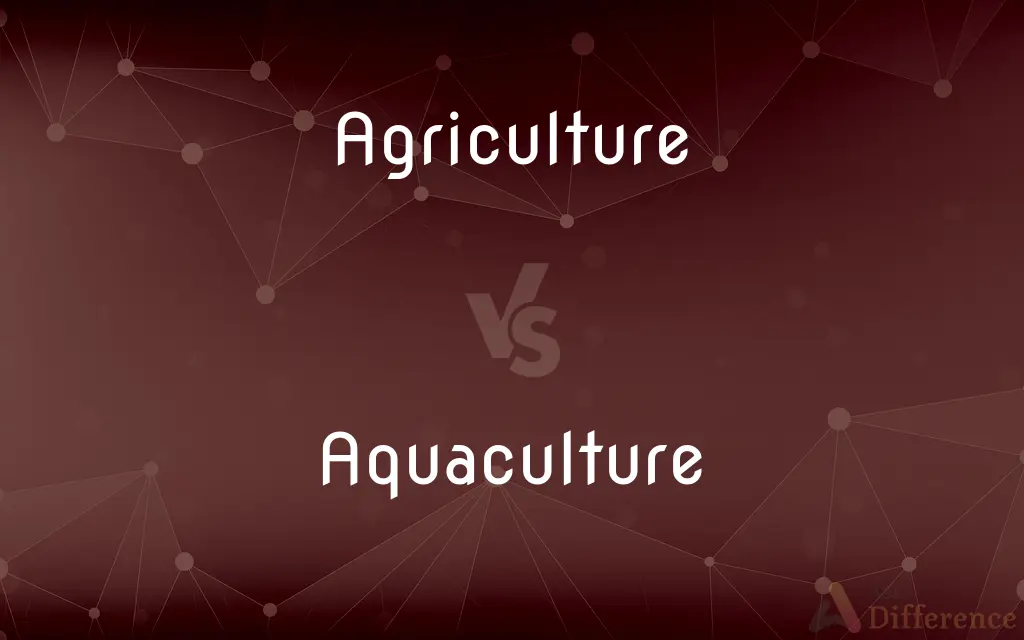Agriculture vs. Aquaculture — What's the Difference?
By Tayyaba Rehman — Updated on November 2, 2023
Agriculture involves cultivating land and plants, while aquaculture focuses on breeding and raising aquatic organisms in water environments.

Difference Between Agriculture and Aquaculture
Table of Contents
ADVERTISEMENT
Key Differences
Agriculture typically refers to farming activities on land, involving cultivation of crops and raising livestock. Aquaculture, on the other hand, is the farming of aquatic organisms, including fish, crustaceans, and plants.
The main objective of agriculture is to produce food and raw materials, utilizing soil for crop growth and open fields for animal husbandry. In contrast, aquaculture aims at cultivating aquatic species in controlled water environments.
Techniques in agriculture range from traditional methods to advanced agrotechnology. Aquaculture employs various techniques like tanks, enclosures, and ponds to rear aquatic species.
Environmental impact is a concern for both; agriculture affects land use and water resources, while aquaculture deals with water quality and ecosystem interactions.
Both agriculture and aquaculture contribute significantly to global food security, but they require different knowledge bases and infrastructure to be effectively managed.
ADVERTISEMENT
Comparison Chart
Environment
Land-based
Water-based
Organisms
Plants, land animals
Fish, shellfish, aquatic plants
Techniques
Plowing, seeding, irrigation
Fish farming, mariculture
Main Purpose
Food production, raw materials
Cultivating aquatic species
Environmental Impact
Soil erosion, deforestation
Water pollution, habitat disruption
Compare with Definitions
Agriculture
The activity or business of growing crops and raising livestock.
He owns a piece of land dedicated to agriculture.
Aquaculture
The cultivation of aquatic organisms in controlled environments.
Advances in aquaculture have improved fish farming techniques.
Agriculture
The practice of cultivating soil, growing crops, and raising livestock.
Agriculture is the backbone of the rural economy.
Aquaculture
Farming of aquatic organisms, including fish, mollusks, and seaweed.
He started an aquaculture business focusing on shrimp farming.
Agriculture
The sector of the economy concerned with primary food production.
She pursued a career in agriculture, focusing on sustainable practices.
Aquaculture
The practice of growing aquatic species in freshwater or saltwater.
Aquaculture contributes significantly to global food security.
Agriculture
The practice of farming, including cultivation of the soil.
Agriculture has evolved considerably over the centuries.
Aquaculture
The breeding, rearing, and harvesting of fish, shellfish, and aquatic plants.
Aquaculture is vital for sustainable seafood production.
Agriculture
The art or science of cultivating the ground, including the harvesting of crops, and the rearing and management of livestock
Aquaculture
The production of seafood from farming rather than wild fishing.
Aquaculture is essential for meeting the world's growing seafood demand.
Agriculture
The science, art, and business of producing crops and raising animals.
Technological advances in agriculture have increased crop yields.
Aquaculture
Aquaculture (less commonly spelled aquiculture), also known as aquafarming, is the controlled cultivation ("farming") of aquatic organisms such as fish, crustaceans, mollusks, algae and other organisms of value such as aquatic plants (e.g. lotus).
Agriculture
Agriculture is the practice of cultivating plants and livestock. Agriculture was the key development in the rise of sedentary human civilization, whereby farming of domesticated species created food surpluses that enabled people to live in cities.
Aquaculture
The cultivation of marine or freshwater organisms, especially food fish or shellfish such as salmon or oysters, under controlled conditions. Also called aquafarming.
Agriculture
The science, art, and business of cultivating soil, producing crops, and raising livestock; farming.
Aquaculture
The cultivation of aquatic produce such as aquatic plants, fish, and other aquatic animals.
Agriculture
The art or science of cultivating the ground, including the harvesting of crops, and the rearing and management of live stock; tillage; husbandry; farming.
Aquaculture
The cultivation of aquatic animals, such as fish or shellfish, or of plants, such as seaweed, in a controlled and sometimes enclosed body of water. The term includes use of either salt or fresh water. It is a form of agriculture, but under water.
Agriculture
A large-scale farming enterprise
Aquaculture
Rearing aquatic animals or cultivating aquatic plants for food
Agriculture
The practice of cultivating the land or raising stock
Agriculture
The federal department that administers programs that provide services to farmers (including research and soil conservation and efforts to stabilize the farming economy); created in 1862
Agriculture
The class of people engaged in growing food
Common Curiosities
What are the main products of Agriculture?
Main products include crops, fruits, vegetables, and livestock.
What is Aquaculture?
Aquaculture is the farming of aquatic organisms like fish and shellfish in water.
What are the main products of Aquaculture?
Primarily fish, shellfish, and aquatic plants.
What environments does Agriculture require?
It requires land, suitable soil, and often controlled environmental conditions.
Can Aquaculture be sustainable?
Yes, through responsible farming practices and ecosystem management.
What environments does Aquaculture require?
Aquatic environments like ponds, tanks, or coastal waters.
What is Agriculture?
Agriculture involves farming on land, including crop cultivation and animal husbandry.
What are common practices in Agriculture?
Practices include plowing, planting, irrigation, and harvesting.
How does Agriculture impact the environment?
It can lead to soil erosion, deforestation, and water resource depletion.
How does Aquaculture impact the environment?
Potential impacts include water pollution and habitat disruption.
Can Agriculture be sustainable?
Yes, through practices like crop rotation, organic farming, and water conservation.
What are challenges in Aquaculture?
Challenges include disease management, genetic diversity, and regulatory issues.
What are common practices in Aquaculture?
Includes fish farming, maintaining water quality, and feeding aquatic species.
What are challenges in Agriculture?
Challenges include climate change, pest management, and land availability.
How important is Aquaculture for food security?
Increasingly important, especially for providing sustainable seafood options.
How important is Agriculture for food security?
It's crucial, as it provides the majority of the world's food supply.
Share Your Discovery

Previous Comparison
Snapper vs. Squire
Next Comparison
Dip vs. DunkAuthor Spotlight
Written by
Tayyaba RehmanTayyaba Rehman is a distinguished writer, currently serving as a primary contributor to askdifference.com. As a researcher in semantics and etymology, Tayyaba's passion for the complexity of languages and their distinctions has found a perfect home on the platform. Tayyaba delves into the intricacies of language, distinguishing between commonly confused words and phrases, thereby providing clarity for readers worldwide.
















































